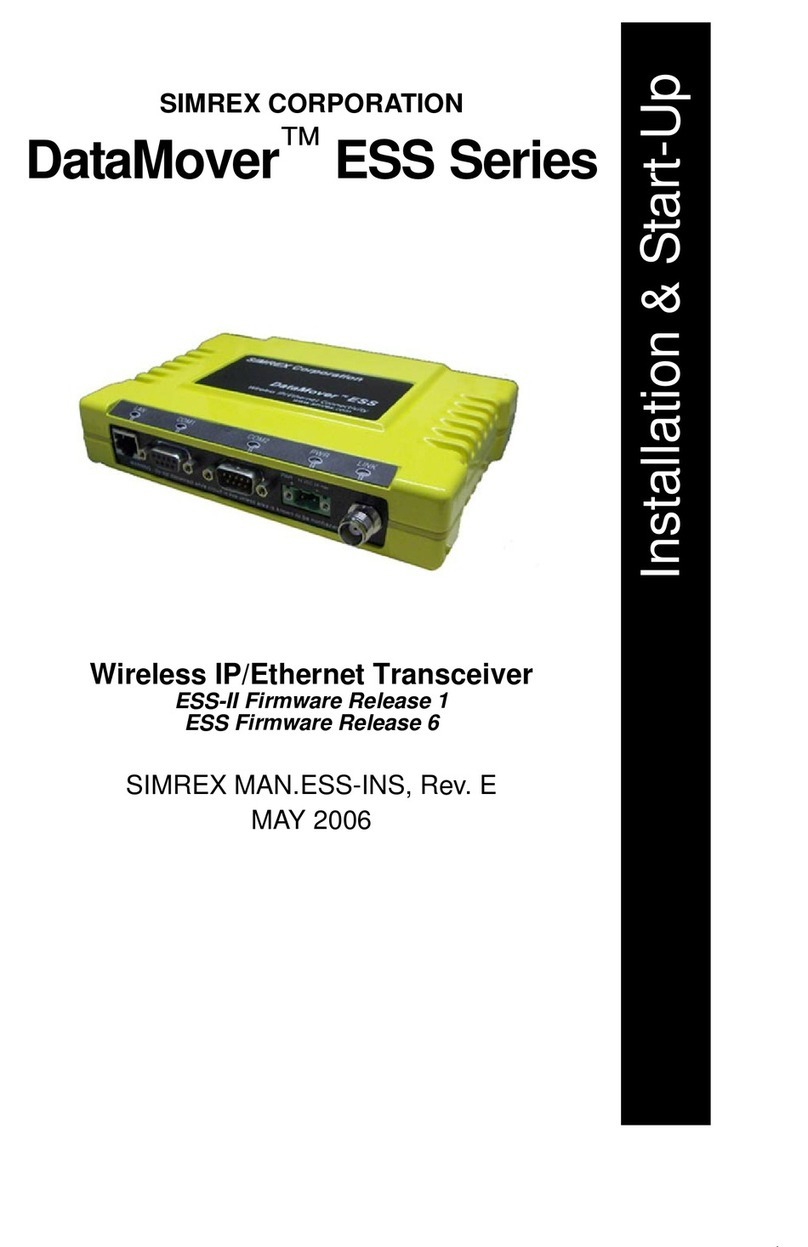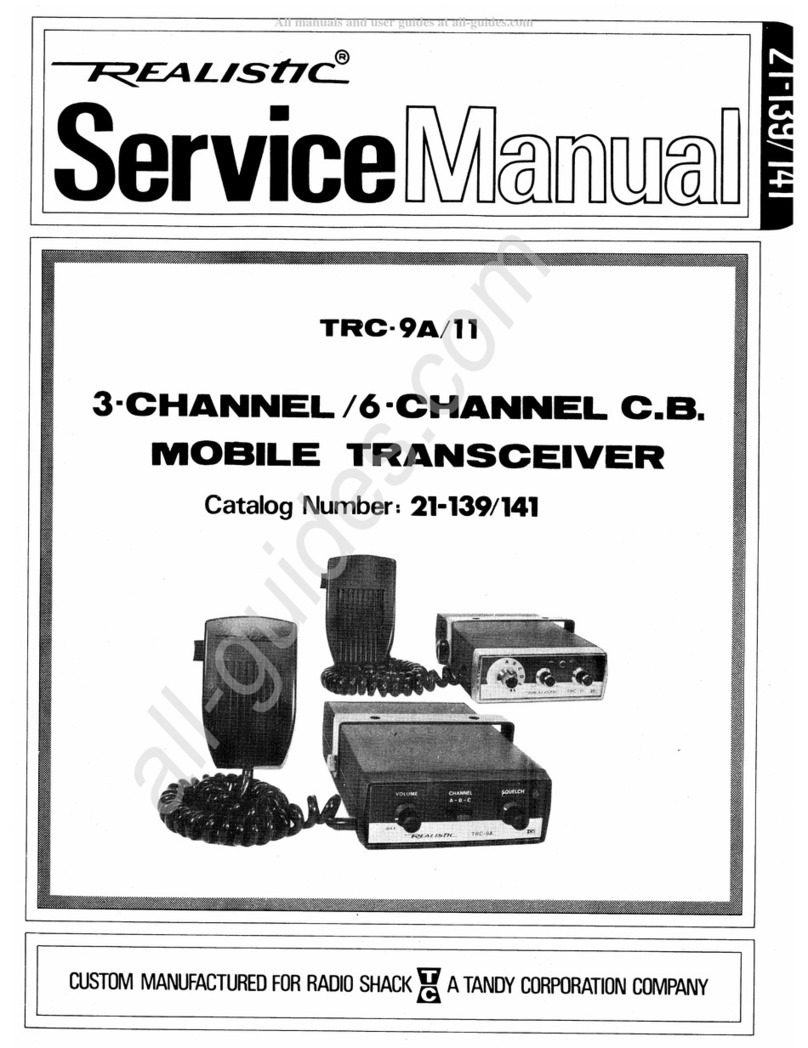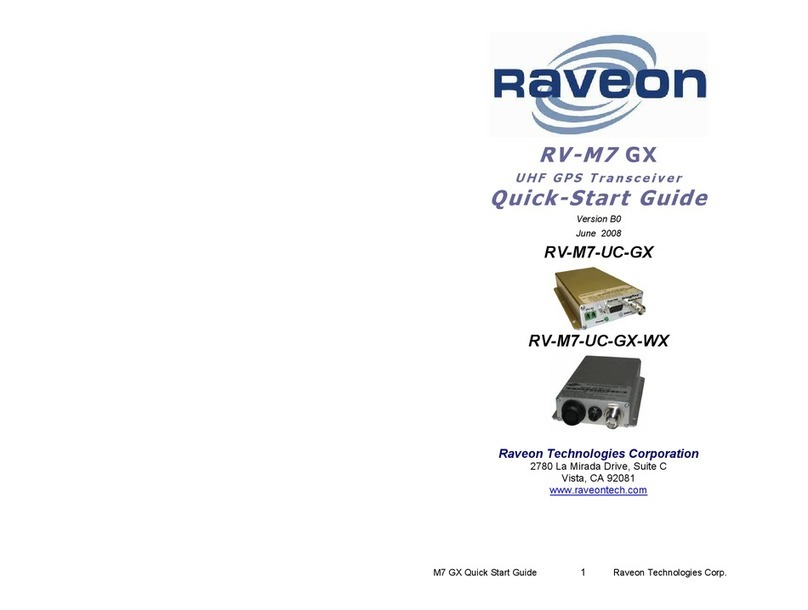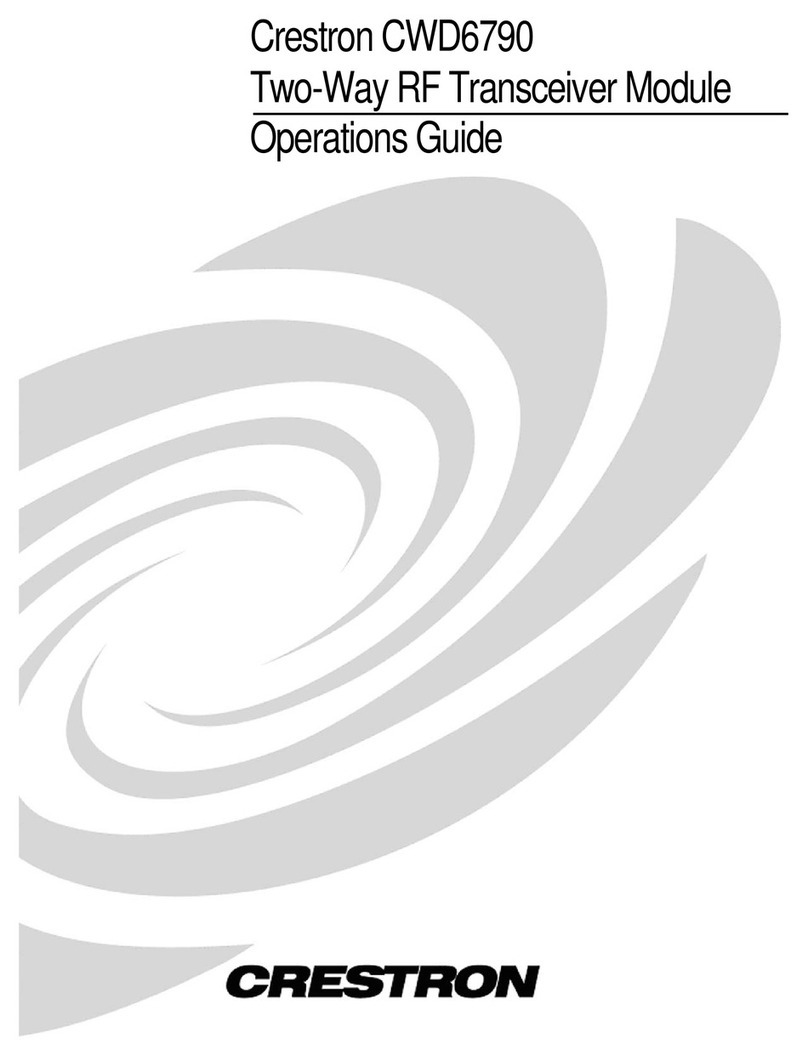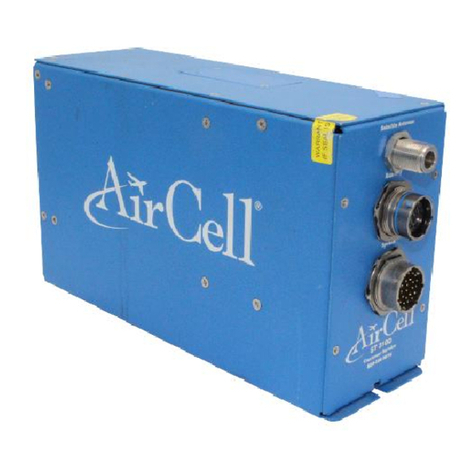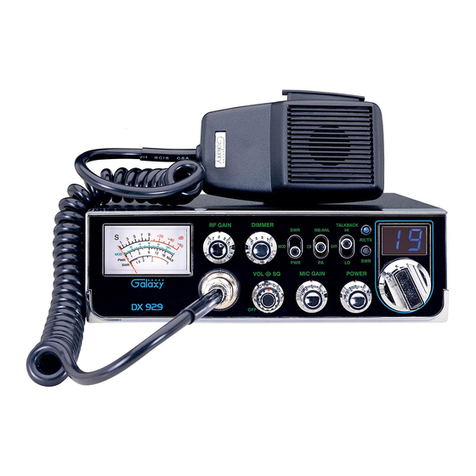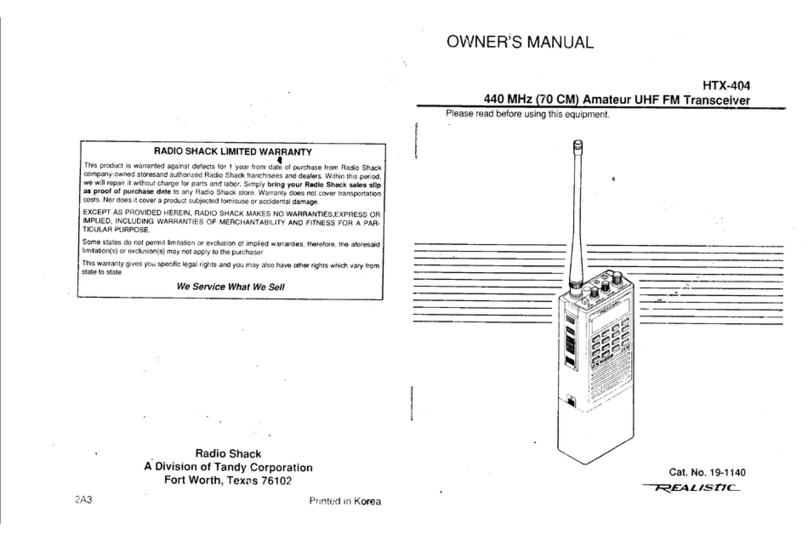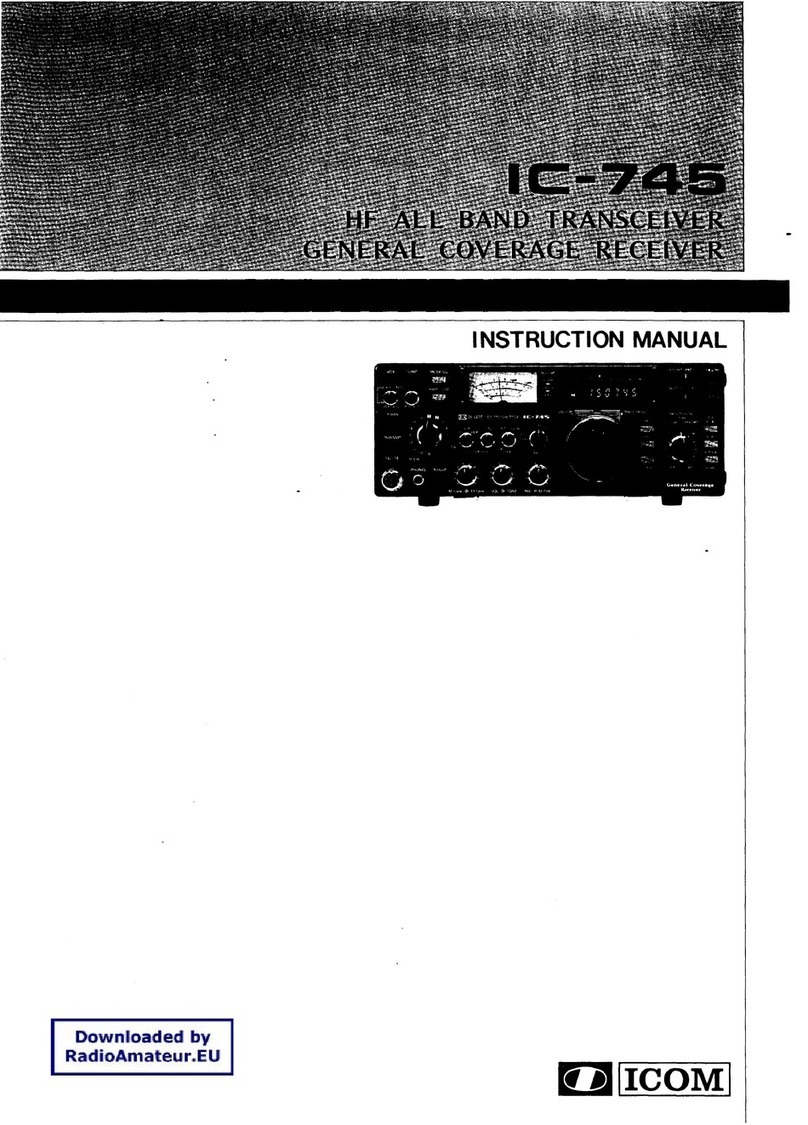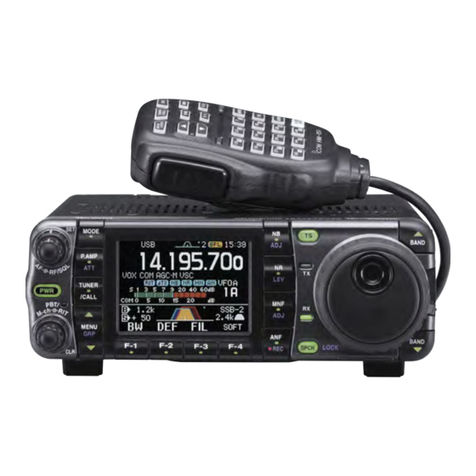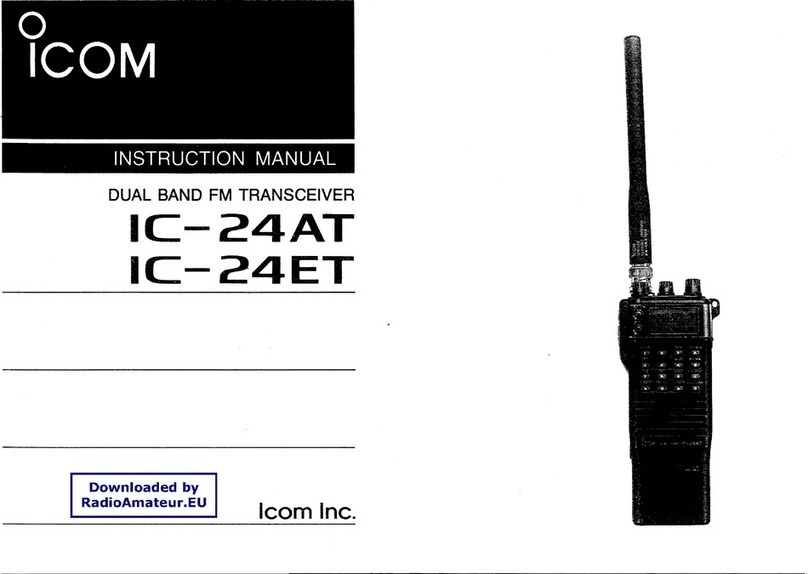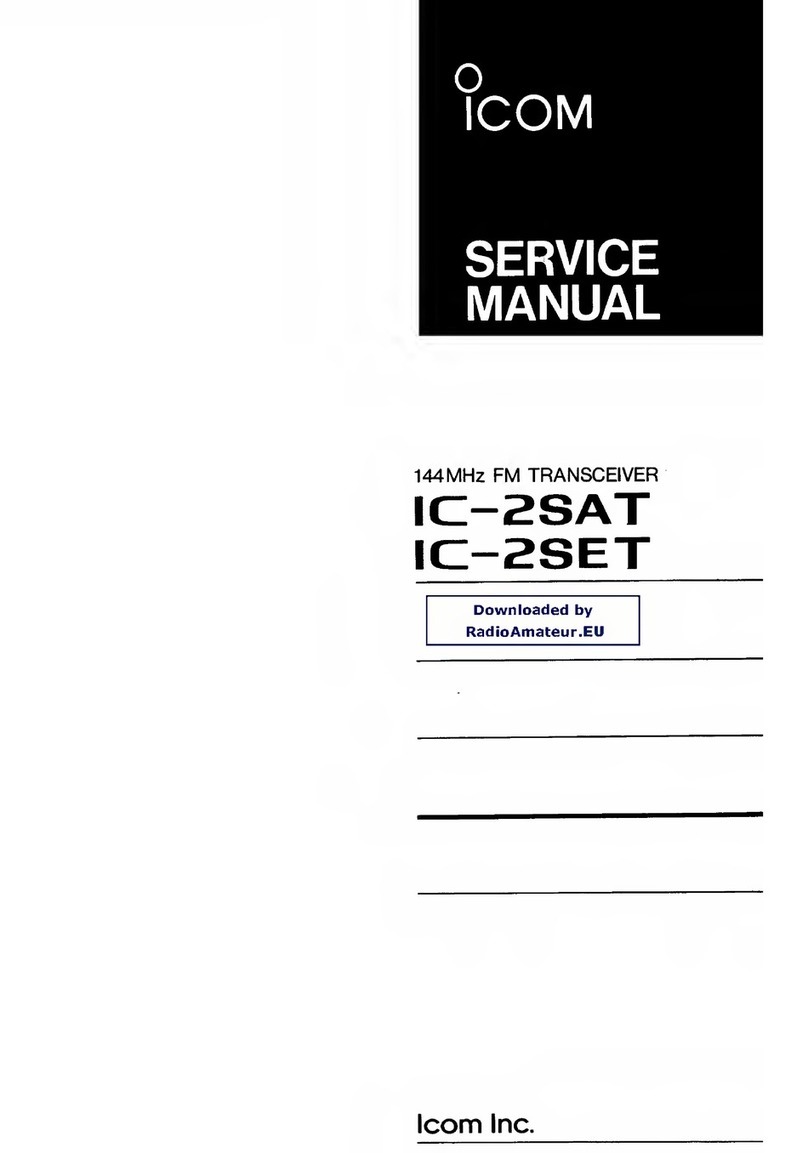SIMREX DataMover ESS User manual

User’s Guide
SIMREX MAN.ESS-01, Rev. F
MARCH 2006
Wireless IP/Ethernet Transceiver
DataMover ESS-II Firmware Release 1
DataMover ESS Firmware Release 6.2.1
DataMover ESS
DataMoverTM ESS
DataMoverTM ESS-II
SIMREX Corporation


SIMREX MAN.ESS-01, Rev. F DataMover ESS User’s Guide i
SIMREX CORPORATION
TABLE OF CONTENTS
1 PRODUCT OVERVIEW AND APPLICATIONS .......... 1
1.1 PRODUCT DESCRIPTION................................................................................................... 3
1.1.1 Model Offerings ..........................................................................................................................5
1.1.2 Differences Between ESS and iNET-II .......................................................................................6
1.2 APPLICATIONS.................................................................................................................... 6
1.2.1 Wireless LAN ..............................................................................................................................6
1.2.2 Point-to-Point LAN Extension .....................................................................................................7
1.2.3 Backhaul for Serial Radio Networks ...........................................................................................7
1.2.4 Multiple Protocols and/or Services .............................................................................................8
1.2.5 Wireless LAN with Mixed Services .............................................................................................9
1.2.6 Upgrading Older Wireless Network with
Serial Interfaces ..................................................................................................................................10
1.2.7 High-Speed Mobile Data ...........................................................................................................10
1.3 NETWORK DESIGN CONSIDERATIONS...........................................................................11
1.3.1 Extending Network Coverage with Repeaters ..........................................................................11
1.3.2 Protected Network Operation using Multiple Access Points .....................................................13
1.3.3 Collocating Multiple Radio Networks ........................................................................................13
1.4 MDS CYBER SECURITY SUITE........................................................................................ 14
1.5 ACCESSORIES.................................................................................................................. 16
2 TABLETOP EVALUATION AND TEST SETUP ....... 19
2.1 OVERVIEW......................................................................................................................... 21
2.2 STEP 1—INSTALL THE ANTENNA CABLING .................................................................. 21
2.3 STEP 2—MEASURE & CONNECT THE PRIMARY POWER............................................ 22
2.4 STEP 3—CONNECT PC TO THE TRANSCEIVER ........................................................... 22
2.5 STEP 4—REVIEW TRANSCEIVER CONFIGURATION ....................................................23
2.5.1 Getting Started .........................................................................................................................23
2.5.2 Procedure .................................................................................................................................23

ii DataMover ESS User’s Guide SIMREX MAN.ESS-01, Rev. F
SIMREX CORPORATION
2.5.3 Basic Configuration Defaults ....................................................................................................23
2.6 STEP 5—CONNECT LAN AND/OR SERIAL EQUIPMENT............................................... 24
2.7 STEP 6—CHECK FOR NORMAL OPERATION ................................................................ 25
3 EMBEDDED MANAGEMENT SYSTEM ................... 27
3.1 MS INTRODUCTION..........................................................................................................29
3.1.1 Differences in the User Interfaces ............................................................................................29
3.2 ACCESSING THE MENU SYSTEM................................................................................... 31
3.2.1 Methods of Control ...................................................................................................................32
3.2.2 PC Connection & Log In Procedures .......................................................................................32
3.2.3 Navigating the Menus ...............................................................................................................37
3.3 BASIC DEVICE INFORMATION......................................................................................... 38
3.3.1 Starting Information Screen ......................................................................................................38
3.3.2 Main Menu ................................................................................................................................39
3.3.3 Configuring Basic Device Parameters ......................................................................................40
3.4 CONFIGURING NETWORK PARAMETERS ..................................................................... 42
3.4.1 Network Configuration Menu ....................................................................................................42
3.4.2 IP Address Configuration Menu ...............................................................................................44
3.4.3 Ethernet Port Configuration Menu ............................................................................................45
3.4.4 DHCP Server Configuration .....................................................................................................46
3.4.5 SNMP Agent Configuration ......................................................................................................48
3.5 RADIO CONFIGURATION.................................................................................................. 50
3.5.1 Radio Configuration Menu ......................................................................................................50
3.5.2 Mobile Data Configuration ........................................................................................................57
3.6 CONFIGURING THE SERIAL INTERFACES..................................................................... 60
3.6.1 Overview ..................................................................................................................................60
3.6.2 Serial Data Port Configuration Menu ........................................................................................63
3.6.3 Configuring for UDP Mode .......................................................................................................64
3.6.4 Configuring for TCP Mode ........................................................................................................67
3.6.5 Configuring for PPP Mode ........................................................................................................70
3.6.6 IP-to-Serial Application Example ..............................................................................................71
3.6.7 Point-to-Point Serial-to-Serial Application Example .................................................................72
3.6.8 Point-to-Multipoint Serial-to-Serial Application Example ..........................................................73
3.6.9 Mixed Modes ............................................................................................................................75
3.7 CYBER SECURITY CONFIGURATION ............................................................................. 77
3.7.1 Device Security ........................................................................................................................77

SIMREX MAN.ESS-01, Rev. F DataMover ESS User’s Guide iii
SIMREX CORPORATION
3.7.2 Wireless Security ......................................................................................................................79
3.7.3 RADIUS Authentication ............................................................................................................81
3.7.4 RADIUS Configuration .............................................................................................................82
3.7.5 Certificate Management (Remote transceivers only) ...............................................................83
3.8 PERFORMANCE VERIFICATION...................................................................................... 84
3.8.1 Performance Information Menu ................................................................................................84
3.8.2 Network Performance Notes ....................................................................................................95
3.9 MAINTENANCE.................................................................................................................. 99
3.9.1 Reprogramming Menu ............................................................................................................100
3.9.2 Configuration Scripts Menu ....................................................................................................105
3.9.3 Authorization Keys Menu .......................................................................................................114
3.9.4 Auto-Upgrade/Remote-Reboot Menu .....................................................................................114
3.9.5 Radio Test Menu ....................................................................................................................115
3.9.6 Ping Utility Menu ....................................................................................................................117
3.9.7 Reset to Factory Defaults .......................................................................................................117
4 TROUBLESHOOTING AND
RADIO MEASUREMENTS .....................................119
4.1 TROUBLESHOOTING...................................................................................................... 121
4.1.1 Interpreting the Front Panel LEDs ..........................................................................................121
4.1.2 Troubleshooting Using the Embedded Management System ................................................122
4.1.3 Using Logged Operation Events .............................................................................................126
4.1.4 Alarm Conditions ....................................................................................................................126
4.1.5 Correcting Alarm Conditions ..................................................................................................128
4.1.6 Logged Events ........................................................................................................................129
4.2 RADIO (RF) MEASUREMENTS....................................................................................... 131
4.2.1 Antenna System SWR and Transmitter Power Output ...........................................................132
4.2.2 Antenna Aiming ......................................................................................................................133
5 PLANNING A RADIO NETWORK .......................... 135
5.1 INSTALLATION PLANNING ............................................................................................. 137
5.1.1 General Requirements ...........................................................................................................137
5.1.2 Site Selection .........................................................................................................................139
5.1.3 Terrain and Signal Strength ....................................................................................................139
5.1.4 Antenna & Feedline Selection ................................................................................................140
5.1.5 How Much Output Power Can be Used? ...............................................................................143
5.1.6 Conducting a Site Survey .......................................................................................................143
5.1.7 A Word About Radio Interference ...........................................................................................144
5.2 dBm-WATTS-VOLTS CONVERSION CHART.................................................................. 147

iv DataMover ESS User’s Guide SIMREX MAN.ESS-01, Rev. F
SIMREX CORPORATION
6 TECHNICAL REFERENCE ..................................... 149
6.1 DATA INTERFACE CONNECTORS................................................................................. 151
6.1.1 LAN Port .................................................................................................................................151
6.1.2 COM1 Port .............................................................................................................................152
6.1.3 COM2 Port .............................................................................................................................152
6.2 FUSE REPLACEMENT PROCEDURE ............................................................................ 153
6.3 TECHNICAL SPECIFICATIONS....................................................................................... 154
6.4 CHANNEL HOP TABLE.................................................................................................... 157
6.5 SNMP USAGE NOTES..................................................................................................... 159
6.5.1 Overview ................................................................................................................................159
7 GLOSSARY OF TERMS & ABBREVIATIONS ....... 165
Copyright Notice
This publication is protected by U.S.A. copyright law. Copyright 2006, SIMREX Corporation. All
rights reserved.
ISO 9001 Registration
SIMREX Corporation DataMover products adheres to the internationally-accepted ISO 9001
quality system standard.
To our Customers
We appreciate your patronage. You are our business. We promise to serve and anticipate your
needs. We will strive to give you solutions that are cost effective, innovative, reliable and of the
highest quality possible. We promise to build a relationship that is forthright and ethical, one that
builds confidence and trust.
What Products are Covered in this Manual?
This manual covers two members of the SIMREX DataMover ESS Transceiver Series, both of
which are designed to be operated under the FCC’s Part 15 license-free rules. The ESS radio is a
Frequency Hopping Spread Spectrum (FHSS) transceiver that operates at data speeds of 256 and
512 kbps.
The ESS-II is a similar design, but it is certified under the Digital Transmission System (DTS) pro-
visions of FCC Part 15 and can operate at data speeds of 512 or 1024 kbps. Operational differences
between these two models are identified, as necessary, in this manual.
NOTE: DataMover ESS and DataMover ESS-II transceivers are not over-the-air compatible.

SIMREX MAN.ESS-01, Rev. F DataMover ESS User’s Guide v
SIMREX CORPORATION
Other DataMover ESS Documentation
InstallationGuide—The associatedDataMover ESSInstallationGuide, P/NMAN.ESS-INSTALL,
is provided with the transceiver and is limited to essential information needed for installers. The
installation guide assumes some guidance to installers will be provided by the readers of this
manual. This includes such things as antenna selection, radio communication site survey tools and
techniques, and network design.
Related Materials on the Internet—Data sheets, frequently asked questions, case studies, applica-
tion notes, firmware upgrades and other updated information is available on the SIMREX Web site
at www.simrex.com.
About SIMREX Corporation
For almost 2 decades, SIMREX Corporation’s wireless products have been providing wireless net-
working solutions with applications in SCADA, telemetry, telecommunications, mobile data and
online transaction markets. SIMREX Corporation provides licensed and unlicensed solutions,
installed worldwide.
The majority of SIMREX DataMover radios deployed are still installed and performing within our
customers' wireless networks. That’s because our DataMover products are designed and manufac-
tured according to ISO 9001 control guidelines and meet stringent global quality standards.
Thanks to our durable products and comprehensive solutions, SIMREX is a wireless leader in
industrial automation—including oil and gas production and transportation, water/wastewater
treatment, supply and transportation, electric transmission and distribution and many other utility
applications. SIMREX is also at the forefront of wireless communications for private and public
infrastructure and online transaction processing. Now is an exciting time for SIMREX and our cus-
tomers as we look forward to further demonstrating our abilities in new and emerging markets.
As your wireless needs change you can continue to expect more from SIMREX. We'll always put
the performance of your network above all. Visit us at www.simrex.com for more information.
OPERATIONAL & SAFETY NOTICES
UL/CSA Notice
This product is available for use in Class 1, Division 2, Groups A, B, C & D Hazardous Locations. Such locations are
defined in Article 500 of the National Fire Protection Association (NFPA) publication NFPA 70, otherwise known as
the National Electrical Code.
The transceiver has been recognized for use in these hazardous locations by two independent agencies —Underwriters
Laboratories (UL) and the Canadian Standards Association (CSA). The UL certification for the transceiver is as a Rec-
ognized Component for use in these hazardous locations, in accordance with UL Standard 1604. The CSA Certifica-
tion is in accordance with CSA STD C22.2 No. 213-M1987.
UL/CSA Conditions of Approval: The transceiver is not acceptable as a stand-alone unit for use in the hazardous
locations described above. It must either be mounted within another piece of equipment which is certified for
hazardous locations, or installed within guidelines, or conditions of approval, as set forth by the approving agencies.
These conditions of approval are as follows:
Professional installation required. The radio equipment described in this guide emits radio
frequency energy. Although the power level is low, the concentrated energy from a direc-
tional antenna may pose a health hazard. Do not allow people to come closer than 23 cm
(9 inches) to the antenna when the transmitter is operating in indoor or outdoor environ-
ments. More information on RF exposure is on the Internet at
www.fcc.gov/oet/info/documents/bulletins.
RF Exposure

vi DataMover ESS User’s Guide SIMREX MAN.ESS-01, Rev. F
SIMREX CORPORATION
The transceiver must be mounted within a separate enclosure which is suitable for the intended application.
The antenna feedline, DC power cable and interface cable must be routed through conduit in accordance with the
National Electrical Code.
Installation, operation and maintenance of the transceiver should be in accordance with the transceiver's installation
manual, and the National Electrical Code.
Tampering or replacement with non-factory components may adversely affect the safe use of the transceiver in haz-
ardous locations, and may void the approval.
A power connector with screw-type retaining screws as supplied by SIMREX must be used.
Do not disconnect equipment unless power has been switched off or the area is known to
be non-hazardous.
Refer to Articles 500 through 502 of the National Electrical Code (NFPA 70) for further
information on hazardous locations and approved Division 2 wiring methods.
FCC Part 15 Notices
The transceiver series complies with Part 15 of the FCC Rules. Operation is subject to the following two conditions:
(1) this device may not cause harmful interference, and (2) this device must accept any interference received, including
interference that may cause undesired operation. This device is specifically designed to be used under Section 15.247
of the FCC Rules and Regulations. Any unauthorized modification or changes to this device without the express
approval of SIMREX Corporation may void the user’s authority to operate this device. Furthermore, the DataMover
ESS is intended to be used only when installed in accordance with the instructions outlined in this manual. Failure to
comply with these instructions may also void the user’s authority to operate this device.
Part 15 rules also require that the Effective Isotropic Radiated Power (EIRP) from an DataMover ESS installation not
exceed 36 dBm. Refer to Antenna & Feedline Selection on Page 140 for more information.
Industry Canada RSS Notices
Operation is subject to the following two conditions: (1) this device may not cause interference, and (2) this device
must accept any interference, including interference that may cause undesired operation of the device.
To reduce potential radio interference to other users, the antenna type and its gain should be chosen so that the Equiv-
alent Isotropic Radiated Power (EIRP) is not more than that permitted for successful communication.
This device as been designed to operate with the antennas listed below, and having a maximum gain of 12 dB.
Antennas not included in this list or having a gain greater than 12 dB are strictly prohibited for use with this device.
The required antenna impedance is 50 ohms. Refer to Table 5-3 on Page 146 for a list of antennas acceptable for use
with this transceiver.
Manual Revision and Accuracy
This manual was prepared to cover a specific version of firmware code. Accordingly, some screens and features may
differ from the actual unit you are working with. While every reasonable effort has been made to ensure the accuracy
of this publication, product improvements may also result in minor differences between the manual and the product
shipped to you. If you have additional questions or need an exact specification for a product, please contact our Cus-
tomer Service Dept. using the information at the back of this guide. In addition, manual updates can often be found on
the SIMREX Web site at www.simrex.com.
Environmental Information
The manufacture of this equipment has required the extraction and use of natural resources. Improper disposal may
contaminate the environment and present a health risk due to hazardous substances contained within. To avoid dissem-
ination of these substances into our environment, and to limit the demand on natural resources, we encourage you to
use the appropriate recycling systems for disposal. These systems will reuse or recycle most of the materials found in
this equipment in a sound way. Please contact SIMREX Corporation or your supplier for more information on the
proper disposal of this equipment.
EXPLOSION
HAZARD!

SIMREX MAN.ESS-01, Rev. F DataMover ESS User’s Guide 1
SIMREX Corporation
1PRODUCT OVERVIEW
AND APPLICATIONS
1 Chapter Counter Reset Paragraph
Contents
1.1 PRODUCT DESCRIPTION .....................................................3
1.1.1 Model Offerings ........................................................................5
1.1.2 Differences Between ESS and ESS-II .....................................6
1.2 APPLICATIONS.......................................................................6
1.2.1 Wireless LAN ...........................................................................6
1.2.2 Point-to-Point LAN Extension ...................................................7
1.2.3 Backhaul for Serial Radio Networks .........................................7
1.2.4 Multiple Protocols and/or Services ...........................................8
1.2.5 Wireless LAN with Mixed Services ...........................................9
1.2.6 Upgrading Older Wireless Network with
Serial Interfaces ..................................................................................10
1.2.7 High-Speed Mobile Data ..........................................................10
1.3 NETWORK DESIGN CONSIDERATIONS ..............................11
1.3.1 Extending Network Coverage with Repeaters .........................11
1.3.2 Protected Network Operation using Multiple Access Points ....13
1.3.3 Collocating Multiple Radio Networks ........................................13
1.4 SIMREX CYBER SECURITY SUITE.......................................14
1.5 ACCESSORIES.......................................................................16

2 DataMover ESS User’s Guide SIMREX MAN.ESS-01, Rev. F
SIMREX Corporation

SIMREX MAN.ESS-01, Rev. F DataMover ESS User’s Guide 3
SIMREX Corporation
1.1 PRODUCT DESCRIPTION
The SIMREX DataMover ESS transceiver provides an easy-to-install
wireless local area network (WLAN) service with long range and secure
operation. It supports both Ethernet and serial data interface options at
over-the-air data speeds of up to 1 Mbps (ESS-II) and 512 kbps (ESS).
NOTE: For information on the DataMover ESS ENI, which provides
expanded gateway and protocol conversion capabilities not
found in the DataMover ESS (DF1 to EIP, and MODBUS to
MODBUS TCP conversions), refer to the SIMREX ESS/ENI
Supplement.
Invisible place holder
Figure 1-1. The SIMREX DataMover ESS Transceiver
Rugged Packaging The transceiver is housed in a compact and rugged cast-aluminum case
that need only be protected from direct exposure to the weather. It con-
tains a single printed circuit board with all necessary components for
radio operation and data communications. The only user-serviceable
component inside the case is a fuse on the DC power input line.
Simple Installation Most installations employ an omni-directional antenna at the Access
Point (AP) location and a directional antenna at each Remote unit. The
antenna is a vital link in the system and must be chosen and installed cor-
rectly. Consult INSTALLATION PLANNING on Page 138 for guidance
on choosing suitable installation sites and antennas.
For basic services, simply connect an antenna, connect your Ethernet
LAN to the transceiver’s LAN port, apply primary power, set a few oper-
ating parameters, and you are done. No license is required for operation
in the U.S.A., Canada, and many other countries. Check requirements
for your region before placing the transceiver in service.
Secure Operation Data network security is a vital issue in today's wireless world. The
DataMover ESS radios provide multiple tools to help you build a net-
work that minimizes the risk of eavesdropping and unauthorized access.
Some are inherent in the radio's operation, such as the use of 900 MHz
spread-spectrum transmissions; others include data encryption,
enabling/disabling remote access channels, and password protection.

4 DataMover ESS User’s Guide SIMREX MAN.ESS-01, Rev. F
SIMREX Corporation
Remember, security is not a one-step process that can simply be turned
on and forgotten. It must be practiced and enforced at multiple levels,
24 hours-a-day and 7 days-a-week. See “SIMREX CYBER SECURITY
SUITE” on Page 14 for more information about the transceiver’s secu-
rity tools.
Robust Radio
Operation The transceiver is designed for frequency-hopping spread-spectrum
operation in the license-free 900 MHz Industrial, Scientific, and Med-
ical (ISM) band. It can provide reliable communications at distances up
to 25 miles (40 km) over favorable terrain, even in the presence of weak
signals or interference. Frequency hopping allows the transceiver to
avoid interference from other transmitters in the same band, and pro-
vides frequency diversity for more reliable transmission. The
over-the-air MAC increases reliability by adding retries to failed mes-
sages.
The DataMover ESS-II transceiver, which is certified to operate under
DTS rules (hopping not required), also hops in order to achieve the same
benefits that are realized with the DataMover ESS transceiver which is
certified under FHSS rules.
Flexible Services Users with a mixture of equipment having Ethernet and serial data inter-
faces can choose to use one or two of the user-configurable serial ports
through the use of a Remote Dual Gateway. This flexibility allows the
transceiver to provide services in data networks that are being migrated
from legacy serial/EIA-232-based hardware to the faster and more
easily interfaced Ethernet world.
Flexible
Management Configuration, commissioning, troubleshooting and other maintenance
activities can be done locally or remotely. Four different modes of
access are available: local RS-232 console, local or remote IP access
(via Telnet or SSH), web browser (HTTP, HTTPS, and SNMP
(v1/v2/v3). The text-based interface (RS-232 console Telnet and SSH)
is implemented in the form of easy-to-follow menus, and the terminal
server configuration includes a wizard to help you set up the units cor-
rectly.
Transceiver
Features The transceiver’s design makes the installation and configuration easy,
while allowing for changes in the future.
• Long Range—Up to 25 miles (40 km) in line-of-sight condi-
tions. Repeater stations may be used to extend the operational
range. (Refer to TECHNICAL SPECIFICATIONS on Page 154
for more detailed information on range.)
• Industrial-Grade Product—Extended temperature range for
trouble-free operation in extreme environments
• Robust Radio Communications—Designed to operate in dense,
high-interference environments
• Robust Network Security—Prevents common attack schemes
and hardware from gaining access or control of network. Com-
mon attack events logged and reported by alarms.

SIMREX MAN.ESS-01, Rev. F DataMover ESS User’s Guide 5
SIMREX Corporation
• High Speed—1 Mbps (ESS-II) is 100-times faster than 9.6 kbps
radios. (ESS transceiver speed is 512 kbps).
• Plug-and-Play Connectivity—Ethernet bridge configuration
option requires minimal setup
• Serial Ports—Gateway for serial-based equipment to IP/Ether-
net networks with embedded terminal server. Site-to-site con-
figurations are also possible.
• Single hardware package provides configuration as Access
Point or Remote
1.1.1 Model Offerings
The transceiver comes in two primary models—Access Point and
Remote. Three types of Remote Gateways are available—the Ethernet
Bridge, the Serial Gateway, and the Dual Gateway supporting both
IP/Ethernet and serial services. Table 1-1 summaries the different inter-
face abilities for each type.
A unit can be configured by the owner to operate as an Access Point or
as a Remote with some restrictions. Only the Dual Gateway Remote
units can be reconfigured as an Access Point. Ethernet Bridge and a
Serial Gateway Remotes cannot be reconfigured as Access Point unless
they are first upgraded to Dual Gateway type. This is accomplished with
an “Authorization Key” purchased from the factory. Each one of these
individual software keys is associated with the serial number of the cor-
responding unit.
Table 1-1. Transceiver Models and Data Interface Services
Model Type LAN1COM11COM2
Access Point3N/A Yes Yes Yes
Remote… Ethernet
Bridge2Yes No No
Serial
Gateway2No Yes Yes
Dual Gateway3Yes Yes Yes
NOTES
1.Provides access to the embedded Management System on all units.
2.Can be upgraded to Dual Gateway with an Authorization Key.
3.Can be configured as an Access Point or Dual Gateway through the
embedded Management System.

6 DataMover ESS User’s Guide SIMREX MAN.ESS-01, Rev. F
SIMREX Corporation 1.1.2 Differences Between ESS and ESS-II
The ESS and ESS-II Transceivers, while similar in many respects, do
have some key differences. The main differences are summarized in
Table 1-2:
Table 1-2. Transceiver Differences (ESS vs. ESS-II)
NOTE: The DataMover ESS and DataMover ESS-II transceivers are
not over-the-air compatible.
1.2 APPLICATIONS
The following sections provide illustrations of typical transceiver instal-
lations. This is meant as an overview only. It is recommended that a net-
work manager be involved in all installation planning activities.
1.2.1 Wireless LAN
The wireless LAN is the most common application of the transceiver. It
consists of a central control station (Access Point) and one or more asso-
ciated Remote units, as shown in Figure 1-2 on Page 7. A LAN provides
communications between a central WAN/LAN and remote Ethernet
segments. The operation of the radio system is transparent to the com-
puter equipment connected to the transceiver.
The Access Point is positioned at a location from which it can commu-
nicate with all of the Remote units in the system. Commonly, this is a
high location on top of a building or communications tower. Messages
are exchanged at the Ethernet level. This includes all types of IP traffic.
A Remote transceiver can only talk over-the-air to an Access Point unit
(AP). Peer-to-peer communications between Remotes can only take
place indirectly via the AP. In the same fashion, an AP can only talk
over-the-air to associated Remote units. Exception: Two APs can com-
municatewith eachother “off-the-air”through theirEthernetconnectors
using a common LAN/WAN.
Characteristic ESS ESS-II
Data Rate 256/512 kbps 512 kbps/1 Mbps
FCC Certification
Type FHSS DTS
Encryption RC4-128 AES-128
Channel size 316.5 kHz 600 kHz
Channel operation Zones Channels
Firmware Specific for ESS Specific for ESS-II

SIMREX MAN.ESS-01, Rev. F DataMover ESS User’s Guide 7
SIMREX Corporation
Invisible place holder
Figure 1-2. Typical Wireless LAN
1.2.2 Point-to-Point LAN Extension
A point-to-point configuration (Figure 1-3) is a simple arrangement
consisting of an Access Point and a Remote unit. This provides a com-
munications link for the transfer of data between two locations.
Invisible place holder
Figure 1-3. Typical Point-to-Point Link
1.2.3 Backhaul for Serial Radio Networks
One of the primary design features of the transceiver is to provide a path
for serial devices to migrate to IP/Ethernet. Many radio networks in
operation today still rely on serial networks at data rates of 9600 bps or
less. These networks can use the transceiver as a means to continue
using the serial service, while allowing the rest of the infrastructure to
migrate to an IP format.
A Remote transceiver using one serial port for the data stream, and the
other for network-wide diagnostics can support operational radio net-
works built with SIMREX serial-based radios, such as DataMover
Transparent, DataMover SS and others. In the case of radios using a
single port for data and diagnostics, the capabilities are doubled. The
data streams are delivered to an IP socket in an application, or in serial
format using the Access Point.
Remote
Remote
Access Point
R
emote
R
emote LAN
LAN
WAN/LAN
LAN
LAN
LAN/WAN
Access Point Remote
LAN

8 DataMover ESS User’s Guide SIMREX MAN.ESS-01, Rev. F
SIMREX Corporation Invisible place holder
Figure 1-4. Backhaul Network
1.2.4 Multiple Protocols and/or Services
Prior to the DataMover ESS, two radios were often used to service two
different types of devices (typically connected to different SCADA
hosts). An ESS or ESS-II radio provides this functionality with a single
remote radio. Each of the two serial ports can be connected via IP to dif-
ferent SCADA hosts, transporting different (or the same) protocols.
Both data streams are completely independent and the transceiver pro-
vides seamless simultaneous operation as shown in Figure 1-5 on
Page 8.
Invisible place holder
Figure 1-5. Multiple Protocol Network
By using a single radio, the cost of deployment is cut in half. Beyond
requiringonlyone radioinsteadof two,thebiggest costreductioncomes

SIMREX MAN.ESS-01, Rev. F DataMover ESS User’s Guide 9
SIMREX Corporation
from using half of the required infrastructure at the remote site: one
antenna, one feedline, one lightning protector and ancillary hardware.
Other cost reductions come from the system as a whole, such as reduced
management requirements. And above all, the potential for future appli-
cations that run over Ethernet and IP, such as video for remote surveil-
lance.
1.2.5 Wireless LAN with Mixed Services
The ESS transceiver is an excellent solution for a long-range industrial
wireless LAN. It offers several advantages over commercial solutions—
primarily improved performance over extended distances. The rugged
construction of the radio and its extended temperature range make it an
ideal solution even in harsh locations. In extreme environments, a
simple NEMA enclosure is sufficient to house the unit.
The transceiver trades higher speed for longer range. Commercial
802.11a/b/g solutions are designed to provide service to relatively small
areas such as offices, warehouses and homes. They provide high data
rates but have limited range. The ESS transmits at a higher power level,
uses a different frequency band, has higher sensitivity, and a narrower
channel to concentrate the radio energy and reach farther distances. It is
designed for industrial operation from the ground up.
IP-based devices that may be used with the transceiver include a new
breed of more powerful Remote Terminal Units (RTUs) and Program-
mable Logic Controllers (PLCs). These, as well as other devices, may
be used in applications ranging from SCADA/telemetry monitoring,
web-based video, security monitoring, and voice over IP. Figure 1-6
shows a typical wireless IP network.
Invisible place holder
Figure 1-6. Extended-Range LAN with Mixed Applications

10 DataMover ESS User’s Guide SIMREX MAN.ESS-01, Rev. F
SIMREX Corporation 1.2.6 Upgrading Older Wireless Network with
Serial Interfaces
Millions of wireless data products have been sold in the last two decades
for licensed and license-free operation, many of them sold by SIMREX
Corporation. There are several ways that these systems can benefit from
incorporating ESS equipment. The chief advantages are interface flexi-
bility (serial and Ethernet in one unit), and higher data throughput. By
taking advantage of its built-in serial and Ethernet interfaces, the trans-
ceiver is well suited to replace leased lines, dial-up lines, or existing
MAS 900 MHz data transceivers.
Replacing Legacy Wireless Products
In most cases, legacy radio transceivers supporting serial-interface
equipment can be replaced with ESS transceivers. Legacy equipment
can be connected to the transceiver through the COM1or COM2 port with
a DB-25 to DB-9 cable wired for EIA-232 signaling. The COM2 port
supports all standard EIA-232 signaling and acts as a data-terminal
equipment device (DTE).
NOTE: Several previous SIMREX-brand products had non-standard
signal lines on their interface connectors (for example, to
control sleep functions and alarm lines). These special func-
tions are not provided nor supported by the ESS transceiver.
Consult equipment manuals for complete pinout information.
Supplement legacy wireless network with IP services
The ESS Dual Gateway model can support up to two serial devices and
one Ethernet connection at the same time. The serial interfaces (COM1
and COM2) operate in two different modes: Connectionless UDP and
connection-orientated TCP.
In the UDP mode, the transceiver supports point-to-multipoint
serial-port to serial-port connectivity. In the TCP mode, it supports
point-to-point Ethernet/IP to serial port connectivity.
For further details on the transceiver’s Serial Gateway interface modes,
see “CONFIGURING THE SERIAL INTERFACES” on Page 61.
1.2.7 High-Speed Mobile Data
The ESS radios support high-speed data communications in a mobile
environment. Remote radios roam between different access points, pro-
viding seamless transitions and continuous coverage. For additional
information on configuring a mobile network, refer to Mobile Data Con-
figuration on Page 58.

SIMREX MAN.ESS-01, Rev. F DataMover ESS User’s Guide 11
SIMREX Corporation
1.3 NETWORK DESIGN
CONSIDERATIONS
1.3.1 Extending Network Coverage with Repeaters
What is a Repeater System?
A repeater works by re-transmitting data from outlying remote sites to
the Access Point and vice-versa. It introduces some additional
end-to-end transmission delay but provides longer-range connectivity.
In some geographical areas, obstacles can make communications diffi-
cult. These obstacles are commonly large buildings, hills, or dense
foliage. These obstacles can often be overcome with a repeater station.
Option 1—Using two transceivers to form a repeater station
(back-to-back repeater)
Although the range between transceivers can be up to 40 km (25 miles)
over favorable terrain, it is possible to extend the range considerably by
connecting two units together at one site in a “back-to-back” fashion to
form a repeater, as shown in Figure 1-7. This arrangement should be
used whenever the objective is to utilize the maximum range between
stations.Inthiscase, using high-gain Yagi antennas at each location will
provide more reliable communications than their counterparts—omnidi-
rectional antennas.
Invisible place holder
Figure 1-7. Typical LAN with a Repeater Link
Overview Two transceivers may be connected “back-to-back” through the LAN
Ports to form a repeater station. (The cable must be a “cross-over”
Ethernet cable for this to work). This configuration is sometimes
required in a network that includes a distant Remote that would other-
wise be unable to communicate directly with the Access Point station
due to distance or terrain.
The geographic location of a repeater station is especially important. A
site must be chosen that allows good communication with both the
Access Point and the outlying Remote site. This is often on top of a hill,
building, or other elevated terrain from which both sites can be “seen”
Access Point
Remote
Remot
e
Remote
Remote
Access
Point
LAN/WAN
REPEATER
Crossover Cable
LAN
LAN
LAN
Ethernet
POINT-TO-POINT LINK

12 DataMover ESS User’s Guide SIMREX MAN.ESS-01, Rev. F
SIMREX Corporation
by the repeater station antennas. A detailed discussion on the effects of
terrain is given in Section 5.1.2, Site Selection (beginning on Page 140).
The following paragraphs contain specific requirements for repeater
systems.
Antennas Two antennas are required at this type of repeater station—one for each
radio. Measures must be taken to minimize the chance of interference
between these antennas. One effective technique for limiting interfer-
ence is to employ vertical separation. In this arrangement, assuming
both are vertically polarized, one antenna is mounted directly over the
other, separated by at least 10 feet (3 Meters). This takes advantage of
the minimal radiation exhibited by most antennas directly above and
below their driven elements.
Another interference reduction technique is to cross-polarize the
repeater antennas. If one antenna is mounted for polarization in the ver-
tical plane, and the other in the horizontal plane, an additional 20 dB of
attenuation can be achieved. (Remember that the corresponding stations
should use the same antenna orientation when cross-polarization is
used.)
Network Name The two radios that are wired together at the repeater site must have dif-
ferent network names. To set or view the network names, see “STEP 3—
CONNECT PC TO THE TRANSCEIVER” on Page 22 for details.
Option 2—Using the AP as a Store-and-Forward Packet
Repeater
A wireless network can be extended through the use of an alternate
arrangement using the Access Point as a repeater to re-transmit the sig-
nals of all stations in the network. The repeater is a standard transceiver
configured as an Access Point, and operating in Store and Forward
mode. (See Figure 1-8.)
Invisible place holder
Figure 1-8. Typical network with store-and-forward repeater
As with the conventional repeater described in Option 1 above, the loca-
tion of a store and forward repeater is also important. A site must be
chosen that allows good communication with both the Access Point and
the outlying Remote site. This can be on the top of a hill, building, or
other elevated terrain from which all sites can be “seen” by the repeater
Remote
Remote
Remote
Remote
Access Point
LAN/WAN
REPEATER
LAN
LAN
LAN
This manual suits for next models
1
Table of contents
Other SIMREX Transceiver manuals
